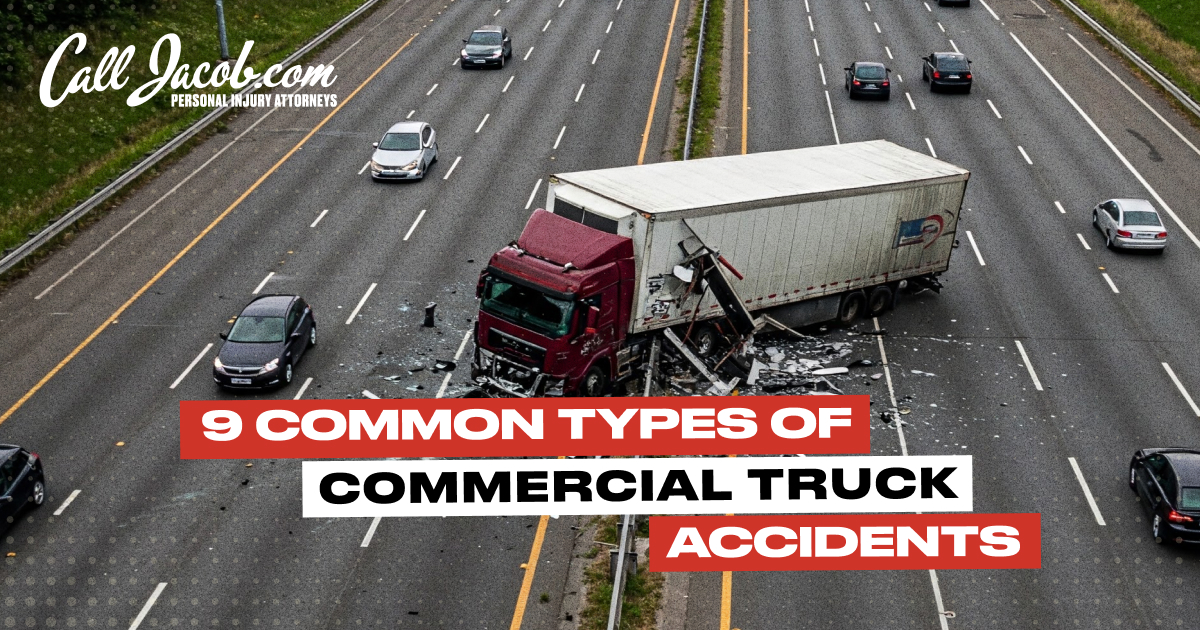Commercial truck and tractor-trailer accidents can cause substantially more damage than other vehicles, disproportionately harming occupants in passenger vehicles in cases of two-vehicle crashes. The size and weight of large commercial vehicles make them more prone to certain types of truck accidents, such as jackknifing, rollovers, and other collisions. Read on to learn the 9 most common types of commercial truck accidents and who is liable in the case of an accident.
1. Rear-Ending
Rear-end collisions happen when a truck collides with the back of another vehicle, often because of tailgating, distracted driving, or sudden stops. Commercial trucks are usually much larger and heavier than other vehicles and as such require significantly more time to stop safely. They may be unable to react quickly enough in these cases.
2. Jackknife Accidents
A jackknife accident is when a truck’s back end or trailer swings out at a sharp angle relative to the cab, about 90 degrees, causing the wheels to lock and the truck to skid. Jackknife accidents are usually a consequence of slippery roads or sudden breaking, which cause the back-end to lose traction. Poorly balanced cargo can also make trailers more likely to lose traction and swing out.
This type of truck accident may block multiple traffic lanes and pose serious risks to other vehicles. Jackknife accidents are associated with multi-vehicle pile-ups — for example, if the trailer swings into other lanes, it may collide with multiple vehicles.
3. Rollover Accidents
With a high center of gravity affecting steering and maneuverability, large commercial trucks are more susceptible to rollover crashes compared to other vehicles. High-speed turns, sudden braking, swerving, and similar driving behaviors can cause trucks to roll over, especially in cases of uneven cargo weight distribution or poor road conditions.
Rollover accidents endanger other motorists or pedestrians, and they also have a higher rate of fatality for truck occupants compared to other vehicle types.
4. Underride Collisions
Commercial trucks typically have much more ground clearance than other vehicles, which makes them more susceptible to underride accidents — when a smaller vehicle collides with and becomes lodged under the truck’s trailer. These are among the most dangerous types of commercial truck accidents since the clearance height of commercial trucks often aligns with the head height of occupants in passenger vehicles, resulting in a high risk of traumatic or fatal head and neck injuries.
5. Blind Spot Accidents
Commercial trucks have large blind spots, making it important for drivers to provide extra space to accommodate for limited visibility and reaction time.
Long 18-wheeler trucks, for instance, have significant blind spots on the sides and behind them and may be unable to see where vehicles are following too closely or making aggressive lane changes. The high cabin position gives drivers good visibility of the road ahead, but it also limits their ability to see vehicles that are too close to the front or sides. Many commercial trucks have advanced camera systems and sensors to alert drivers to nearby vehicles, but they don’t eliminate blind spots or risk altogether.
Blind spots can be a contributing factor in many accidents, including:
- Lane change accidents and sideswipes
- Rear-ends from tailgating
- Wide turns at intersections
6. Tire Blowouts
When commercial trucks experience tire blowouts, particularly on the front tires, drivers can easily lose control of the vehicle. Blowouts can therefore increase the risk of rollovers, sudden swerves into other lanes, rear-end crashes, and multi-car collisions.
The size and weight of trucks put enormous stress on the wheels, axles, and tire rubber, and the tires are more prone to overheating and rupture. Other factors increase the risk of tire blowouts in commercial trucks, such as:
- Cargo overloading
- Old, brittle, or worn tires
- Road debris
- Poor tire maintenance
7. T-Bone Collisions
T-bone accidents refer to side-impact collisions, where one vehicle collides with another at a perpendicular angle. These accidents are dangerous for all vehicles since the sides of vehicles typically offer less protection to occupants than the front or rear. T-bone truck accidents are most commonly due to failure to yield at stop signs or red lights, whether because of speeding, distraction, blind spots, or other behaviors, but commercial trucks carry additional risk in these scenarios.
With limited maneuverability and visibility, commercial trucks are less able to stop in time. If the truck strikes another vehicle, it carries significantly more force than passenger vehicles and is more likely to crush or severely harm the smaller vehicle and its occupants. Underride accidents are more common with T-bone collisions in cases where the smaller vehicle strikes the truck. T-bone collisions also have a higher risk of rollovers and spilled cargo.
8. Cargo Accidents
Cargo loading for trucks is subject to certain rules to optimize safety, typically regarding:
- Weight limits: Overloaded trucks are more likely to experience tire blowouts, suspension system failure, and limited maneuverability.
- Weight distribution: Unevenly distributed cargo weight can imbalance the truck and increase the risk of rollover or jackknife accidents.
- Cargo securing: Transporting cargo requires specific securing equipment, such as straps, chains, tarps, and other restraints or fasteners, to prevent spillage and sudden weight changes.
9. Head-On Collisions
When a commercial truck is involved in a head-on collision with a smaller vehicle, the size and weight disparities increase the risk of injury. Head-on collisions are more likely in rural areas, where drivers may travel at higher speeds, overtake other traffic on two-lane highways, and become more vulnerable to fatigue or distraction from long periods of uninterrupted driving.
Who Can Be Liable for Commercial Truck Accidents?
Commercial truck accidents aren’t necessarily the driver’s fault, and these collisions often result from several contributing factors for which numerous parties may be liable. Liability depends on the specifics of each accident, such as whether negligence was involved or any laws or regulations were violated.
Employers
Commercial truck companies are responsible for providing adequate training, enforcing safety regulations, and maintaining safe working conditions for drivers. When employers fail to meet these obligations, it can lead to hazardous driving circumstances.
Fatigue is one of the most common causes of truck accidents, and companies must track drivers’ hours to ensure they comply with Hours of Service regulations. If they don’t properly log hours or take appropriate actions when drivers violate these limits, they may contribute to the risk of fatigue-related accidents and be partially liable in the eyes of the law.
Additionally, trucking companies carry insurance specific to the risk of their operations. Dealing with them can be incredibly difficult on your own.
Vehicle manufacturers or maintenance providers
Vehicle manufacturers may be liable if the accident stemmed from defects or problems with the truck’s design or manufacturing. Trucks with faulty brakes that don’t meet safety standards, for instance, may be unable to stop, while faulty tires may be more prone to blowouts. Similarly, maintenance crews of truck fleet managers may be liable if they fail to conduct proper inspections or maintenance that directly lead to mechanical failure that caused an accident.
Government entities
Government agencies responsible for road conditions, signage, or traffic control may be held liable if poor road design or maintenance contributes to an accident. For example, poor lighting or inadequate signage may prevent drivers from seeing upcoming hazards in time.
Other drivers
Other motorists should follow appropriate measures when driving near commercial trucks that have limited maneuverability, braking capacity, and visibility. Negligence by other drivers may interfere with a truck driver’s ability to safely operate their vehicle. See these examples of unsafe motorist driving that may lead to sudden stops, swerves, and other actions that cause commercial truck accidents:
- Failing to yield or obey traffic signs
- Cutting off trucks
- Distracted driving or driving under the influence
- Speeding, tailgating, and other aggressive driving
Injured in a Truck Accident? Contact The Law Offices of Jacob Emrani Today
Tractor-trailer and 18-wheeler accidents may lead to lasting injuries or fatalities, and victims of these collisions may be entitled to compensation for medical bills, lost wages, and other damages. At the Law Offices of Jacob Emrani, our expert truck accident attorneys help you navigate the legal complexities of truck accident cases — call (888) 857-7706 to set up your no-cost case evaluation!



